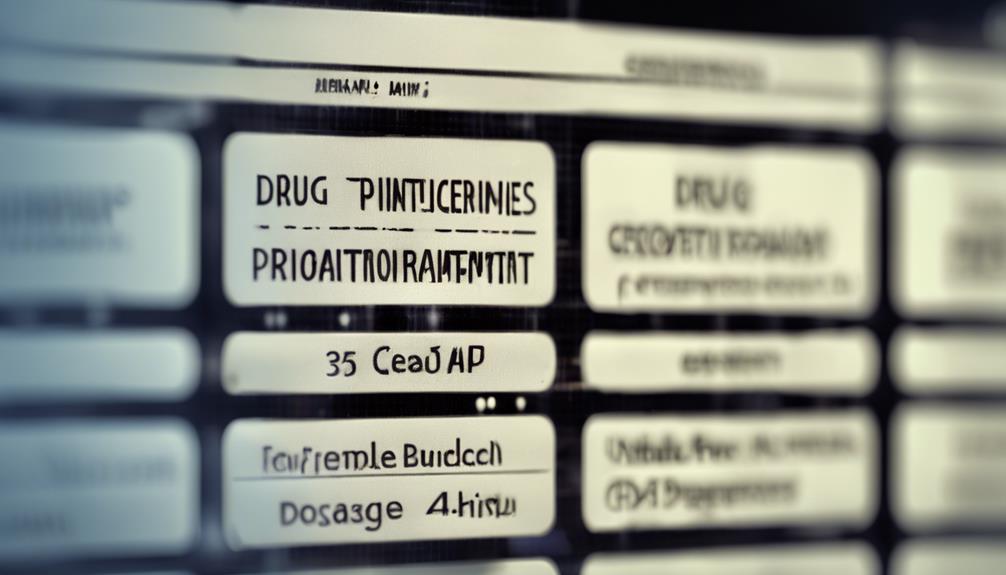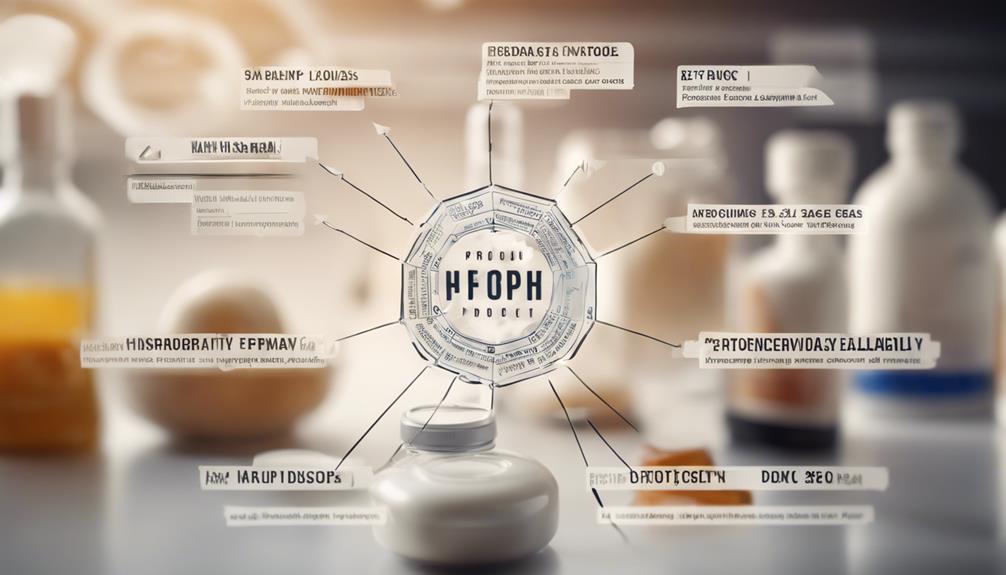If you're looking to understand Structured Product Labeling simply, SPL serves as a standardized format for easily conveying essential pharmaceutical product information. It organizes data efficiently into structured sections within documents, ensuring accessibility to critical details like drug ingredients, dosage forms, indications, and warnings. Based on the HL7 Reference Information Model and standardized in XML format, SPL enhances the quality and accuracy of pharmaceutical information sharing. Further insights into its technical specifications, submission and validation process, benefits, and recent articles can provide a deeper understanding of how SPL functions in the pharmaceutical industry.
Key Takeaways
- SPL is a standardized format for drug information.
- Organizes data into structured sections.
- Ensures accessibility to crucial drug details.
- Based on HL7 Reference Information Model.
- Standardized in XML format for consistency.
SPL Overview
Let's explore an overview of SPL, a structured document markup standard used for drug labeling data communication. SPL stands for Structured Product Labeling, and it serves as a standardized format for conveying essential information about pharmaceutical products. By organizing data into structured sections within an SPL document, this standard ensures that details such as drug ingredients, dosage forms, indications, and warnings are easily accessible and interpretable.
Based on the HL7 Reference Information Model and standardized in XML format, SPL supports regulatory requirements by providing a consistent framework for product labeling content. This uniformity not only facilitates compliance with regulatory guidelines but also enhances the accuracy and accessibility of information for healthcare professionals, patients, and regulatory authorities.
Furthermore, it's worth mentioning that SPL isn't confined to the United States market; its adoption globally promotes interoperability and harmonization in drug labeling practices, benefiting stakeholders across different regions. By utilizing SPL, stakeholders can streamline communication, improve data exchange efficiency, and ensure the consistent representation of crucial drug information.
Technical Specifications

Now, let's address the technical specifications of SPL, focusing on the data requirements and validation tools.
You need to understand the structured data elements like Code Systems and document attributes that SPL mandates.
Be sure to utilize validation tools such as the online SPL Validator to guarantee compliance with FDA regulations.
Data Requirements in SPL
Structured Product Labeling (SPL) mandates specific data requirements, incorporating elements such as document version, registrant information, drug interactions, and adverse reactions. These requirements ensure standardized information presentation and facilitate efficient data exchange.
SPL utilizes various Code Systems like NCI and LOINC to standardize data elements, enhancing consistency across labeling documents. Additionally, DUNS numbers and CFR codes play an important role in identifying and tracking information within SPL submissions.
To maintain compliance, SPL XML files can be viewed using the FDA Style sheet, which helps uphold formatting and content standards.
Before submission to FDA centers such as CDER, CBER, CDRH, and CVM, successful validation of SPL files is necessary. This validation process confirms that the SPL submission meets the required criteria and is accurately formatted for regulatory review.
Adhering to these data requirements in SPL is essential to streamline the labeling process and ensure the accuracy and consistency of drug information within regulatory documents.
Validation Tools for SPL
Validation tools for SPL, such as the online SPL Validator and Schematron technology, are instrumental in ensuring compliance with FDA regulations and specific file requirements. These SPL validation tools play an essential role in the accuracy and completeness of structured product labeling submissions.
Before submitting SPL files to the FDA, it's necessary to undergo thorough validation to guarantee that the data adheres to structured data requirements and includes the necessary LOINC codes for document types.
Successful validation through these tools is crucial for guaranteeing that SPL submissions are both accurate and compliant with regulatory standards. By utilizing the online SPL Validator and Schematron technology, companies can streamline the validation process and identify any potential errors or inconsistencies in their SPL files.
This proactive approach to validation not only enhances the quality of SPL submissions but also helps in avoiding rejections or delays in the approval process.
Submission and Validation

Submitting and validating Structured Product Labeling (SPL) files is an important step in guaranteeing compliance with FDA regulations. Before submitting SPL files to the FDA, it's essential to validate them to meet the established guidelines and validation rules.
FDA Centers such as CDER, CBER, CDRH, and CVM oversee the submission and compliance of SPL files. LOINC codes play a significant role in categorizing document types within SPL submissions.
To guarantee the accuracy and completeness of SPL files, tools like the online SPL Validator are used for validation. Successful validation is a requirement for the submission of SPL files to the FDA.
File Creation Requirements

When creating SPL files, make certain that the SPL Document File name matches the SPL Document ID submitted to the FDA for consistency.
To guarantee accurate submission, consider the following requirements for creating SPL files:
- Include Specific Information: SPL files must contain details such as US Agent, Importer, and Labeler information to meet FDA standards.
- DUNS Numbers Formatting: Make sure that DUNS Numbers in SPL files consist of 9 digits without hyphens to facilitate accurate identification.
- Proper Phone Number Formatting: Phone numbers in SPL submissions should be correctly formatted to adhere to FDA requirements.
Validation rules play an essential role in establishing the accuracy of Establishment Registration and Drug Listing information in SPL submissions.
Electronic Submission Standards

To vital seamless delivery of regulatory information for Structured Product Labeling (SPL), familiarize yourself with the electronic submission standards facilitated through the FDA's Electronic Submissions Gateway (ESG).
The ESG serves as a secure platform for submitting SPL data, supporting file sizes of up to 100GB to meet the diverse needs of different FDA centers.
When submitting information to the FDA, the pharmaceutical industry often utilizes the Electronic Common Technical Document (eCTD) format. It's essential to verify compliance with regulatory standards such as HL7, UNII, and UCUM codes when preparing electronic submissions.
SPL, as a standardized format for product labeling, comes with specific requirements for electronic submission, making adherence to these standards vital for successful submissions through the ESG.
General SPL Requirements

For successful compliance with SPL regulations, understanding the general requirements is necessary. When preparing SPL submissions, meet the following key criteria:
- Drug Establishment Registration: Before submitting SPL files to the FDA, all drug establishments involved in the manufacturing, processing, packing, or holding of drugs must be registered with the FDA. This registration guarantees transparency and regulatory oversight.
- Health Level Seven (HL7): SPL files are structured using the HL7 standard to guarantee consistent formatting and data exchange. Understanding how to utilize HL7 standards is essential for creating accurate and compliant SPL submissions.
- Compliance Documentation: Alongside the SPL files, various compliance documents such as Lot Distribution Reports and Generic Drug Facility Self-Identification must be provided to meet FDA requirements. Ensuring all necessary documentation is complete and accurate is important for successful SPL submissions.
Benefits and Goals

Understanding the benefits and goals of Structured Product Labeling (SPL) is key to appreciating its impact on drug labeling processes and safety standards. SPL aims to ensure timely availability of accurate drug labeling information for review and distribution. The primary goals of SPL are to enhance human readability, facilitate machine processing, and improve information accessibility.
| Benefits | Goals |
|---|---|
| Enhancing patient safety | Enhancing human readability |
| Reducing manual effort in content review | Facilitating machine processing |
| Standardizing format for ingredient names | Improving information accessibility |
| Fostering collaboration between health authorities and industries | – |
| Providing easily accessible content for consumers and systems | – |
Recent Articles Overview

- Brazil's RDC 205/2017: Explore the specifics of Resolution RDC 205/2017 in Brazil, understanding its implications for drug regulations within the country's pharmaceutical landscape.
- Stringent Regulatory Authorities (SRAs): Uncover how SRAs impact the approval processes of drugs, influencing global pharmaceutical markets and ensuring high standards of safety and efficacy.
- DIA Reference Model: Discover the Drug Information Association's (DIA) Reference Model and how it serves as a valuable tool for optimizing drug development processes, streamlining workflows, and enhancing efficiency in the industry.
These recent articles provide an in-depth overview of various facets of drug development and regulatory frameworks worldwide, shedding light on the intricate processes involved in ensuring the safety, efficacy, and compliance of pharmaceutical products.
Stay informed about the latest trends and updates in the pharmaceutical industry to navigate the complexities of drug development effectively.
DCL's Workbooks and Resources

DCL's SPL workbooks efficiently convert pharmaceutical information into SPL format, aiding in regulatory compliance and accurate product data maintenance.
These workbooks include tabs for Generic Self-Identification, NDC Labeler Code, and more, streamlining the conversion process.
Additionally, DCL provides specialized workbooks like the BNCC workbook for Blanket No Change Certification and the Lot Distribution Report workbook for biannual submissions, catering to specific regulatory needs.
SPL Schema and Stylesheet

To effectively implement structured product labeling in compliance with FDA standards, familiarize yourself with the SPL Schema and Stylesheet provided by the FDA. These resources are vital for creating and formatting SPL information accurately. Here's what you need to know:
- FDA SPL Schema: The FDA offers an SPL Schema for implementation, last updated on April 25, 2016. This schema outlines the structure and organization required for SPL submissions.
- FDA SPL Stylesheet: An FDA SPL Stylesheet is also available, last updated on October 24, 2016. This stylesheet assists in presenting SPL data in a clear and consistent manner, improving readability and compliance.
- Feedback and Contact: If you have any feedback or comments on the FDA SPL Schema and Stylesheet, you can direct them to spl@fda.hhs.gov. Your input can contribute to enhancing these pivotal tools for SPL submissions.
Frequently Asked Questions
What Is a Structured Product Labeling?
Structured product labeling (SPL) organizes drug information for communication. It combines text and structured data for easy extraction. SPL, in XML format, meets specific standards and supports global regulations. It guarantees accurate representation using code systems like NCI and LOINC.
What Is a SPL in Fda?
In FDA, SPL, or Structured Product Labeling, acts as the key to accessing drug information. You'll find SPL utilized by FDA divisions like Biologics and Veterinary. DCL can assist in converting your product data to meet FDA standards.
What Is the SPL Label Format?
The SPL label format, based on XML files, organizes data and text sections for easy extraction. It meets FDA criteria, standardizes content, and extends beyond the U.S. using HL7 Reference Information Model. Mandatory data includes version, registrant, and adverse reactions.
What Is SPL in Medical Terms?
In medical terms, SPL stands for Structured Product Labeling. It's a standardized format for conveying drug labeling details. SPL aids in regulatory compliance, guarantees accurate product information, and supports machine-readable content for consistent data across platforms.
Conclusion
Overall, structured product labeling (SPL) is an essential tool for ensuring consistent and accurate information about pharmaceutical products.
Did you know that the FDA has reported a 90% decrease in medication errors since implementing SPL standards?
This statistic highlights the importance of standardized labeling in promoting patient safety and improving healthcare outcomes.










